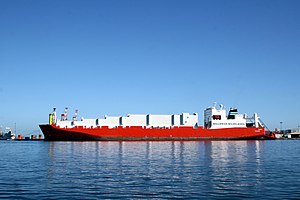MV Tampa was a roll-on/roll-off container ship completed in 1984 by Hyundai Heavy Industries Co., Ltd. in South Korea for the Norway-based firm, Wilhelmsen Lines Shipowning.
 MV Tampa at Papeete, French Polynesia
| |
| History | |
|---|---|
| Name |
|
| Owner | Wilhelmsen Lines Shipowning |
| Port of registry | |
| Builder |
|
| Yard number | 248 |
| Launched | 10 October 1983 |
| Completed | 1984 |
| Identification |
|
| Fate | Scrapped 2 August 2013 |
| Notes | [1] |
| General characteristics | |
| Type | Container ship |
| Tonnage | |
| Length | 262.3 m (860 ft 7 in) |
| Beam | 32.26 m (105 ft 10 in) |
| Draught | 9.78 m (32 ft 1 in) |
| Decks | 12 |
| Speed | 21 knots (39 km/h; 24 mph) |
| Crew | 25 |
| Notes | [2] |
In 2001, the vessel was at the centre of the Tampa affair when its crew rescued 433 refugees in international waters, but the Australian government refused permission for them to disembark on Christmas Island.
Service history
editTampa was launched in late 1983. It was a so-called ro-ro ship. Ro-ro is an abbreviation of roll-on/roll off. These ships are cargo ships designed to carry wheeled cargo, such as cars, motorcycles, trucks, semi-trailer trucks, buses, trailers, and railroad cars, that are driven on and off the ship on their own wheels or using a platform vehicle, such as a self-propelled modular transporter. This is in contrast to lift-on/lift-off (LoLo) vessels, which use a crane to load and unload cargo.
Tampa affair
editIn August 2001, under Captain Arne Rinnan, a diplomatic dispute brewed between Australia, Norway, and Indonesia after Tampa rescued 433 Afghans from a distressed fishing vessel in international waters. The Afghans wanted passage to the nearby Christmas Island. The Australian government sought to prevent this by refusing Tampa entry into Australian waters, insisting on their disembarkment elsewhere, and deploying the Special Air Service Regiment to board the ship.[3][4]
At the time of the incident, Tampa carried cargo worth A$20 million, and 27 crew. The crew of Tampa later received the Nansen Refugee Award for 2002 from the United Nations High Commissioner for Refugees (UNHCR) for their efforts to follow international principles of saving people in distress at sea.
Cocaine smuggling bust
editIn October 2006, Tampa was one of two Wilhelmsen ships involved in a cocaine-smuggling operation intercepted by the New Zealand Customs Service and the Australian Federal Police. Twenty-seven kilograms (60 lb) of cocaine was allegedly attached to the side of the two cargo ships bound for Australia in purpose-built metal pods, although New Zealand authorities stated they did not believe the ship's crew or owners were involved.[5]
See also
editReferences
edit- ^ "Tampa (166504)". Shippingdatabase.com. Retrieved 19 May 2013.
- ^ "MV Tampa". Wilh. Wilhelmsen. 2010. Archived from the original on 4 February 2010. Retrieved 4 June 2010.
- ^ Jason Burke, Jason; Brace, Matthew (2 September 2001). "All Australia can offer is guano island". The Guardian. London. Retrieved 6 August 2022.
- ^ Tampa-saken in Store norske leksikon
- ^ Crewdson, Patrick (27 October 2006). "Tampa one of two ships named in cocaine bust". The Age. Melbourne.
Bibliography
edit- David Marr, Maria Wilkinson: Dark Victory – How a government lied its way to political triumph. Allen & Unwin 2004, ISBN 978-1-74114-447-5.
Further reading
edit- Decision of Justice North, Federal Court of Australia 11 September 2001
- Decision of Full Court overturning decision of Justice North, 18 September 2001
- David Marr & Marian Wilkinson Dark Victory. ISBN 1-74114-447-7
- McPhedran, Ian (2005). The Amazing SAS. HarperCollins. ISBN 0-7322-7981-X.
- News.com.au: Reflections by Julian Burnside on Tampa with public comments published to coincide with 5-year anniversary of the event
- Daniel Ross, Violent Democracy, ch. 5.
- Mary Elzabeth Crock: In the Wake of the Tampa: Conflicting Visions of International Refugee Law in the Management of Refugee Flows. Pacific Rim Journal of Law and Policy, Vol. 12, No. 1, pp. 49–95, 2003.
- Peter Mares: Borderline: Australia's Response to Refugees and Asylum Seekers in the Wake of the Tampa. UNSW Press 2002, ISBN 0-86840-789-5.
External links
edit- NauruWire, an Australia based site Update on status of detainees. Accessed 25 June 2005.